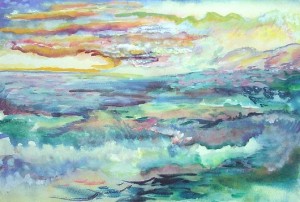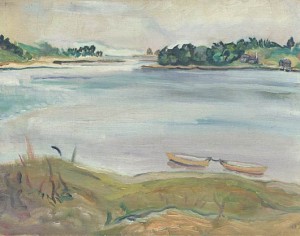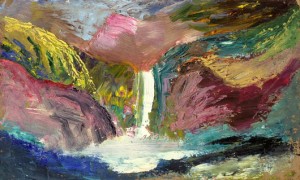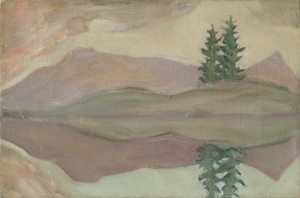We all seem to know E.E. Cummings as a prominent poet of the twentieth century, having read his work either in high school, college, or for pleasure on our own. An innovative and creative individual, Cummings grew in popularity through his work of poetry with its unconventional style, and at times, controversial subject matter. Yet, what Cummings is less known for is his artistic drawings and paintings, which also seem to represent these two qualities of his inventive flair. He began to paint seriously while in college at Harvard, and it is believed that through his interest in art aesthetics, Cummings decided to bring this type of visual orientation into the framework of his poetry as well. At times, some of his poetry can only be understood when seen fully in their specific visual arrangement on the page, like the arrangement of a painting on a canvas.
After peering through some of his collected art work, which is displayed for sale on http://www.eecummingsart.com/, I found a few paintings that portray an ocean or water landscape. The first that I saw, and probably my favorite of the few, is titled “surf: north africa” and was done as a watercolor.

The colors emerge vibrant and various to me, with appearances of blue, purple, pink, green, white, orange, and yellow shading. A view of the surf in the daylight, the colors seem to light up in a glorious, mystical way; and the view is a powerful one, with waves crashing into each other in the middle of the surf, no sign of a coastal landing in sight. What I like the most about this painting is how the sea is designed with the same use of colors as the skyline, where the clouds reflect that similar purple and blue tint, outlined by an orange horizon: it is almost as if the sea is eternal, creating a never-ending effect of ocean elements, absorbed into the rest of the earth’s atmosphere. A muddle of white constitutes near the horizon, making it difficult to tell where the sea ends and the sky begins.

This next painting appears as a scenic view, categorized as oil on canvas board, and is titled “robin hood: maine”. Simple components to a lake landscape, with small boats, grassy lands, trees surrounding the inlet, and houses by the water.

Another vibrant use of color, Cummings paints a waterfall with oil on cardboard. The waterfall is represented with white shading, to defer from the yellow, maroon, green, and blue landscape.

And lastly, Cummings creates a dulled shading of a wooded creek, with oil on canvas. What I found interesting in this painting is how the landscape is reflected identically within the water. The framework to this painting has a romantic feel to it, where nature can serve as a mirror to the rest of the world.
If you’re interested in further reading of Cummings and his work, I recommend “E.E. Cummings Selected Poems”, edited by Richard S. Kennedy, which I used as a reference to this blog entry. This edition to his work provides biographical information, published drawings and paintings, and a great selection of some of Cummings’ finest poetic verses. It’s interesting to see how his poetry reflects the aesthetic elements that can be found within the artwork he created.
